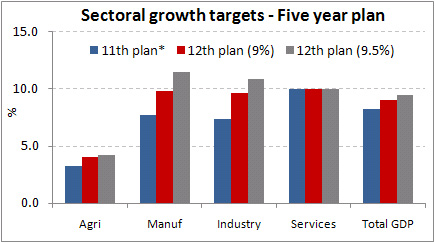History of Planning and Five Year Plan in India :
After Independence, Indian economy was in a poor condition. For a new nation, every sector was to be strengthened from the base thereby strengthening the economy. For all this to happen a consolidated planning was required. So, the government of India constituted an institution called PLANNING COMMISSION in 1950 (Planning commission was replaced by NITI AAYOG in 2014).
The duty of this planning commission is to formulate plans for the effective utilization of country’s resources and it started implementing five- year plans from 1951. The planning commission from its inception in 1951 till its end in 2014 had formulated 12 five year plans.
FIVE YEAR PLANS OF INDIA:
The five-year plans were the set of programmes to be implemented in a five-year term focussing on the problems (or) the sectors which needed attention at that time.
FIRST FIVE YEAR PLAN (1951-56):
In the first five year plan, Government emphasised mainly on agricultural sector.All the sectors were controlled by the government and private sectors had a very minimal role. The plan was successful yielding good results.
Target growth rate: 2.1% Achieved growth rate: 3.6%
SECOND FIVE YEAR PLAN (1956-61):
The second five year plan was based on MAHALANOBIS STRATEGY, which emphasised promotion of heavy industries under Government leader ship and generated revenue will be used for agriculture. Meagre results were attained here.
Target growth rate: 4.5% Achieved growth rate: 4.1%
THIRD FIVE YEAR PLAN (1961-66):
The third five year plan followed inward oriented policy with minimised imports, imposing high import tariffs. The plan failed here resulting drastic downfall of growth rate.
Target growth rate: 5.5% Achieved growth rate: 2.5%
FOURTH FIVE YEAR PLAN (1969-74):
The fourth five year plan emphasised on agriculture and food security was its primary goal. It also emphasised on social justice by providing education and employment to under privileged classes. Still the results are not satisfactory.
Target growth rate: 5.7% Achieved growth rate: 3.3%
FIFTH FIVE YEAR PLAN (1974-79):
In the fifth five year plan, the government recognized the failure of the previous plans and this time the main focus was on anti-poverty and minimum need programmes. This plan yielded good results.
Target growth rate: 4.4% Achieved growth rate: 5.2%
Also Read: Planning Commission of India
SIXTH FIVE YEAR PLAN (1980-85):
The sixth five year plan marked a shift in the industrialization pattern from heavy industries to infrastructure development. Anti- poverty programmes and rural employment programmes were also launched during this period.
Target growth rate: 5.2% Achieved growth rate: 5.3%
SEVENTH FIVE YEAR PLAN (1985-90):
In the seventh five year plan outward looking policy began with exports receiving priority. From this five year plan Liberalisation of Indian economy began.
Target growth rate: 5% Achieved growth rate: 5.8%
EIGHTH FIVE YEAR PLAN (1992-97):
The eighth five year plan completely changed the face of Indian economy. The role of the government is minimized and private sector was given priority. India became a market oriented economy from this period.
Target growth rate: 5.6% Achieved growth rate: 6.8%
NINTH FIVE YEAR PLAN (1997-2002):
Greater role to private sector was continued and new labour, land and legal reforms were introduced in this period.
Target growth rate: 6.7% achieved growth rate: 5.4%
TENTH FIVE YEAR PLAN (2002-07):
Tenth five year plan focussed more on services and IT sector and was able to achieve expected growth rate. But the growth rate in the agriculture sector dropped down.
Target growth rate: 8% Achieved growth rate: 7.8%
ELEVENTH FIVE YEAR PLAN (2007-12):
It emphasised more on agriculture and social sector and environmental sustainability and achieved agricultural growth rate of 4%.
TWELFTH FIVE YEAR PLAN (2012-17):
It is the present five year plan with the target of achieving faster, more inclusive and sustainable growth with development of all sectors and also decided to achieve growth rate of 8%.
Inclusiveness is a multidimensional concept. Which includes following attributes:
- Reduce Poverty
- Improve regional equality across states and within states
- Improve conditions of SCs, STs, OBCs, and minorities
- Generate attractive employment opportunities for youths
- Close gender gap
The twelfth five year plan has listed following 25 monitorable indicators :
Economic Growth
- Real GDP growth at 8%.
- Agriculture growth at 4%.
- Manufacturing growth at 10%.
- Every state must attain higher growth rate than the rate achieved during 11th plan.
Poverty and Employment
- Poverty rate to be reduced by 10% than the rate at the end of 11th plan.
- 5 Crore new work opportunities and skill certifications in non-farm sector.
Education
- Mean years of schooling to increase to 7 years.
- 20 lakh seats for each age bracket in higher education.
- End gender gap and social gap in school enrollment.
Health
- Reduce : IMR to 25; MMR to 1. Increase Child Sex Ratio to 950.
- Reduce Total Fertility Rate to 2.1
- Reduce under nutrition of children in age group 0-3 to half of NFHS-3 levels.
Infrastructure
- Investment in Infrastructure at 9% of GDP
- Gross Irrigated Area 103 million hectare (from 90 million hectare)
- Electricity to all villages; Reduce AT&C losses by 20%.
- Connect Villages with All Weather Roads
- National and State high ways to a minimum of 2 lane standard.
- Complete Eastern and Western Dedicated Freight Corridors.
- Rural Tele-Density to 70%.
- 40 Litres Per Capita Per Day Drinking Water to 50% of rural population; Nirmal Gram Status to 50% of all Gram Panchayats.
Environment and Sustainability
- Increase green cover by 1 million hectare every year.
- 30,000 MW renewable energy during Five Year Period.
- Emission intensity of GDP to be reduced to 20-25% of 2005 levels by 2020.
Service Delivery
- Banking Services to 90% of Indian Households.
- Subsidies and Welfare related payment to be routed through Aadhar based Direct Cash Transfer Scheme.
Also Read: Indian Economy
Thus, the five year plans had been playing a major role in the consolidation of Indian economy since Independence. However there was a need of reform in the process of planning as it was more than half century old and hardly gone through a major upgradation. In a federal structure it is not easy to reform an institution which has been playing essential role in the centre-state financial relations. The erstwhile 50 years old Planning Commission of the socialist era was replaced by NITI Aayog earlier this year. Its role is to act as a think-thank to the government with noted economist Arvind Panagariya as its vice chairman. The government’s idea of NITI Aayog which is nothing but a much needed reformed Planning Commission as per the current economic necessities.
Also Read:
Agriculture in India: Challenges with Agricultural Marketing and APMC Act




